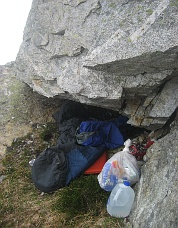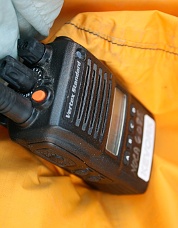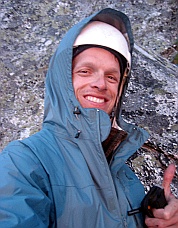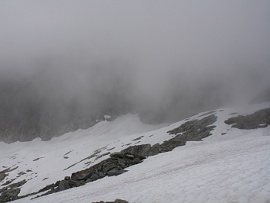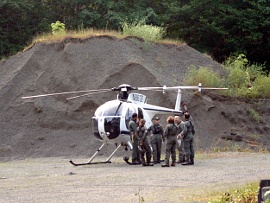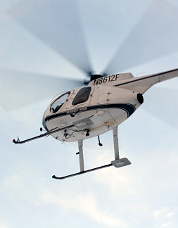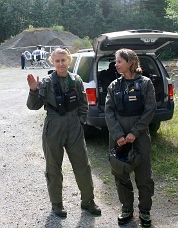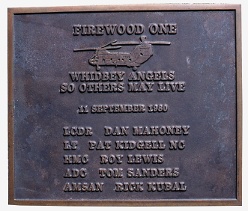|
|
|||||||||
 |
||||||||||
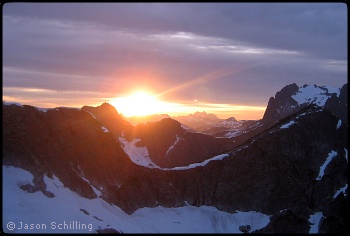 |
||||||||||
|
||||||||||
tranded After I watched the helicopter disappear over Frenzelspitz, dangling Steve and his rescuer, I collapsed onto the narrow ledge. Tears streamed down my face as the sun dipped behind the spires of the Southern Picket Range. My nerves were shattered from the shock and stress of the past ten hours. I kept re-living the day’s events in my mind, partly to convince myself that they had really happened. As I did, my anxiety subsided a little.The backpack that Kevork had left me was very heavy. I rifled through the pack and found a sleeping bag, a thermarest pad, a bivy sack, two gallons of water, a bag of Nutra-Grain bars, peanuts, cashews, cookies and a radio. Physically and mentally wasted, I crawled into the sleeping bag and bivy, tied into the block, and lay down on the thermarest. The last ten hours had been the most intense of my life. I was no longer Steve’s caretaker, and he wasn’t going to die under my watch. The sun was sinking. I sat up on the ledge and watched the stars appear. It was an emotional night. I fiddled with the radio and made contact with someone with the Park Service. They told me that a rescue attempt would be made in the morning and to check back in at 7 a.m. I was content with that bit of information, though the weather forecast was calling for a storm system to move in around noon the next day. Still, I figured that they should have plenty of time in the morning to get me off of the mountain. I passed the night at 6600ft without sleep but with few worries, marveling at my spectacular surroundings. The rising moon illuminated the snowy southern flanks of Mount Fury. I followed the shadows cast by the moon as they shifted throughout the night. Lightning flickered far to the north, which worried me at first. But the flashes were consistently far away, and I never heard thunder. If I focused my gaze northward long enough, I could see a distant snowy peak during each flash. It seemed far enough away to be in Canada. I looked forward to a morning rescue. At first light I sat up and looked to the west. To my utter dismay, a wall of clouds surged over Picket Pass, like they’d been waiting patiently all night for their first chance to enter McMillan Cirque. Low-lying at first, they soon filled the cirque completely. Visibility was no more than 100 meters. I checked in with head climbing ranger Kelly Bush and she informed me that the helicopter was en route. Kelly had given Donn a radio the day before when the helicopter had staged for Steve’s rescue near our camp in Crescent Creek Basin. Over the radio Donn informed me that there was a small cave no more than 60 meters below my ledge that Steph had seen shortly before Steve’s fall. He said it should offer me some protection if the weather worsened. I packed up all of my things, tied the ropes back together, and strapped my pack onto the rescue pack that Kevork had left me. It was unwieldy, but I needed everything in it. Cleaning the cam from the anchor, I rappelled from the cordelette tied around the block that had served as our anchor the day before. I stopped on a ledge to pass the knot and then rappelled to within ten feet of the rope’s end. I could see the cave, just 60 feet below and sharply to the east. I frantically searched for an anchor from which to rappel to the cave. I tried in vain to thread the severed 20-ft section of rope behind a block, but the crack was too thin. In desperation, I placed the cam in a crack, attached a sling, ran the rope through it, and tested it repeatedly. I put myself on rappel and took a deep breath, testing the anchor once more. Most of the nerve-wracking rappel was done as a down-climb, since I did not want to unnecessarily weight my lone anchor. Halfway to the cave, I heard the approach of a helicopter. I tried to shut it out and focus on my rappel. The voice of the pilot on my radio interrupted my concentration, asking me if I could see them. The radio was in my pack so I ignored it for several minutes, until I reached the cave. The noise of the helicopter was quite loud, but I could make out nothing but rock and fog. I dejectedly answered that I could not see them. After a long pause the pilot responded “Well, I suggest you make yourself comfortable,” then he was gone. The cave was basically the eroded lower section of a massive boulder at least 20 feet high, which I hoped was somehow attached to the mountain. A grassy ramp sloped up to its entrance, where the nook was highest, about three feet. The cave diminished to a tiny crack at its back and side. I placed the rope at the foot of my thermarest and the pack on top of the rope to keep my feet off the ground. I dug a small trench on the downhill edge of the packs and then stuck some larger rocks in the trench to prevent myself from sliding downhill. When the rains came I became acutely aware that my feet and lower shins were protruding and exposed to the weather. I was getting colder. “I don’t want to freeze to death in this cave,” I thought, and envisioned an escape. I could rappel to the glacier, down-climb the easy parts, and then traverse west on the glacier to the couloir that leads to Ottohorn-Himmelhorn Col. It was a steep couloir, but I could easily kick steps up to the col and rappel down the other side to base camp, where Donn and Steph would be waiting for me. Or, once on the glacier, I could just hike down into the jungle-like forests of McMillan Creek. Surely there would be safety in the trees. This plan could have worked if I had more gear to use for rappel anchors. But I had only four slings and a mutilated rope. I didn’t have a knife. A set of nuts would have been ideal for the numerous rappels needed to reach the glacier. But dying trying to get off of the mountain seemed better than succumbing to hypothermia. I radioed the Park Service and informed Kelly of my plan. Her exact words were “Stand by. Do not rappel.” She contacted Donn, just a few miles from me on the other side of Mount Terror and asked him what their status was for rescuing me. He responded that it was not safe for them to attempt a rescue and they’d have to wait for the weather to clear and the rock to dry to reassess. Although I understood their reasoning for staying put, I felt hurt and abandoned by their decision. But what could they do? The afternoon and evening of that first day in the cave were some of the darkest hours of my life. The peaceful interlude of the previous night’s bivy was followed by another hell, one that, without Steve, was mine alone to endure. But as the stormy grey haze faded into darkness, I began to believe that I would survive an extended stay in the cave. I knew that as long as my core was warm, I would make it. I thought of Russian and German troops freezing to death in the trenches on the Eastern Front and Shackleton’s men enduring Antarctic cold and wet for two years straight. I knew my situation was not yet so dire.
My survival to this point hinged on several fortunate events since Steve’s fall. Steph and Donn had finished climbing the buttress quickly, mostly simul-climbing, enabling Steve’s rescue the same day as the accident. Kelly Bush had the presence of mind to give radios to Donn and me, as well as the survival backpack prepared for me. Those two decisions, plus Steph’s memory of the cave, likely saved my life. I shudder to think how I would have fared for several consecutive nights on my initial ledge, without shelter or the ability to communicate. Also, had we not had my cell phone, and had Donn and Steph not been able to get a cell signal from atop Terror’s false summit, the outlook for both Steve and me would have been far different. But I was not feeling lucky the first night in the cave. I checked back in with Kelly and settled in for the night. I wore my helmet for insulation from the cold rock and was uncomfortably cocooned in my sleeping bag and bivy sack. I focused on my breathing and slowed everything down, intent on making no unnecessary movements. I willed myself not to cry anymore for fear of wasting precious energy and fluids. My goal was to sleep or enter into a dream-like state. My mind and body were so worn out from the trauma of the past two days that I fell into a deep sleep and did not wake until dawn. Alarmed to find myself halfway out of the cave, I clawed at the ceiling of the cave to pull myself back up. I would repeat this maneuver hundreds of times over the next three days, causing a sore neck and abdominal muscles. The highlights of my days were eating and checking in on the radio. In addition to the assortment of bars and nuts from the Park Service, Steve had left a handful of Clif Bars and packets of energy gel. Kelly Bush’s calm command of the situation enabled me to relax, as did speaking with Donn and my girlfriend, Anna, who were waiting anxiously at Park Headquarters. I had a radio check-in every morning and evening to look forward to. The hours between were filled with boredom and anticipation. I had given up on keeping my feet dry, but my temperature had stabilized. I drifted in and out of sleep, waking to stare at the ceiling not more than two inches from my face. I worried when it rained hard and drips in the cave came closer to my cocoon. I was also concerned about rockfall caused by the constant rains. Textured features of the ceiling’s cave took on bizarre formations. I saw animals, ex-presidents, skulls, and dragons. In retrospect, spending three soggy nights in that crack in the mountain was anticlimactic when compared to the events that Steve and I endured on the day of his accident. My anxiety subsided into boredom. I was mostly obsessed with the weather, and noted even the most minor changes. My requests for weather updates were constant in radio conversations I had with Kelly, Donn and Anna. Despite my single-mindedness, my spirits were lifted by the contact with Donn and Anna. On my third day in the cave, I was filled with a positive attitude that would only increase throughout the day. As dusk approached, I glimpsed the first patch of blue sky in days. Instead of avalanches, rockfall, and waterfalls, the cirque was filled with an eruption of birdsong. As I lay on my side watching the storm dissipate, I heard a scuffle behind me. I rolled over and caught a glimpse of a wood-rat chewing on a Nutri-Grain wrapper. I screamed, alarmed by my first encounter with another living creature in over three days. But I optimistically took the rat’s appearance as yet another positive sign that the weather was changing in my favor. Though there were few hours of darkness, the fourth night on the mountain seemed excruciatingly long. My back was so sore that I could hardly stay in one position for more than a few minutes. I didn’t sleep, too concerned with the weather and the cloud situation in the cirque. The sky cleared shortly after sunrise, but patchy fog moved in and tormented me for the next few hours. At first light, I got out of the cave and started to organize my things. I did a little yoga as the rising sun reflected off Frenzelspitz. I stopped abruptly as clouds rolled back into the cirque, obscuring Mount Fury and the rising sun. Worried that they would persist, I climbed back into my bivy and waited. Escape I shivered on the grassy ledge outside of the cave as the helicopter approached. Kevork again dangled from the machine and pilot Tony Reese communicated his plans to me over the radio. My hopes rose with the helicopter, and Kevork was at my elevation when Tony’s agitated voice came over the radio “Jason, I’m lost in the clouds up here, I just can’t see you or the mountain. We’re going to have to go down to the glacier and wait for a clearing.” Of course I could wait a little while longer. I’d been waiting for the past four days. But if I wasn’t rescued today, I would be devastated. I helplessly watched the helicopter fade to a tiny speck as it descended to the moraine at the foot of Mustard Glacier 3000ft below. I pulled out the sleeping bag to warm up and waited. Within half an hour I noticed a clearing in front of me and a lifting of the cloud ceiling. The helicopter crew geared up for another attempt. I held my breath as Tony ascended again expecting to lose him in the cloud cover once more. But this time he stayed well below the clouds. Kevork landed on my ledge and moved towards me. I unclipped my makeshift anchor perhaps a little too soon as he bumped into me, nearly knocking me off balance. I steadied myself as he tried with much effort to clip into my harness. Again the sound of the carabiner clipping into the belay loop was the most joyful sound I could imagine. Kevork confirmed that he had me and we were off the mountain. I sobbed uncontrollably. Kevork grinned as I patted him on the helmet and muttered my gratitude between sobs. We landed gently on the glacier and I looked up in awe at the incredible soaring buttress of Mount Terror, half obscured by clouds and hemmed in by steep and broken glaciers. Donn, Steph, Anna, Kelly and other rangers from North Cascades and Mount Rainier National Parks were waiting back at the landing pad. The reunion was emotional. The air was so warm and the ground so flat. Every touch and ray of sunlight was like a gift. I was tired, but overjoyed. Kelly hugged me. It was great to finally put a face to the voice that had calmed me throughout my ordeal. In the days that followed my four nights on the North Face of Mount Terror, I experienced a heightened awareness and enjoyment of life and living. I enjoyed every meal, beer, nap in a warm bed, and step on solid ground more than I thought possible. I also visited Steve, and was comforted to see that he was already in the beginning stages of healing. It would take months for his physical injuries to heal, and for us to process what we’d gone through. Our capabilities, experience, judgment and good luck had combined for this fortunate and rare outcome. I can only hope I will always climb with partners as worthy as those I had on Mount Terror. The flip-flops and bolts phase lasted about a week before I was back in the North Cascades, lured by an undying thirst for adventure and love of the mountains. In the months following the accident, I went on to climb several more fantastic North Cascade routes. On more than one occasion, I reunited with Donn or Steph for a climb. These positive experiences helped to put some distance between me and the incident on Mount Terror. The harsh memories of the ordeal have been softened by time. But a passing glance at the bloodstains on my pack and rain jacket reminds me that accidents in the mountains are possible and at times unpreventable. Although newly humbled and awed by the risks inherent in the sport I love, I will be up there again.
|
|
|
||||||||||||||||||||||||||||||||||||||||||
| <<Previous | 1 | 2 | 3 | ||||||||||||||||||||||||||||||||||||||||||||
| ©2010 Northwest Mountaineering Journal | ||||||||||||||||||||||||||||||||||||||||||||
| Site design by Lowell Skoog | ||||||||||||||||||||||||||||||||||||||||||||
